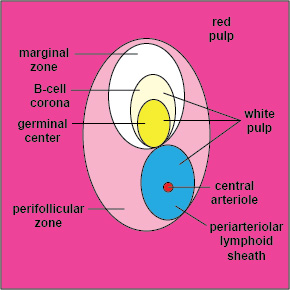
The red pulp makes up the majority of the spleen. This is where old red blood cells are destroyed. Scattered throughout the spleen are areas of white pulp where microbes, cells, and antigens encounter macrophages, dendritic cells, and changing populations of B-lymphocytes and T-lymphocytes. Soluble antigens, blood-borne microbes, and antigen-antibody complexes are filtered out of the blood and phagocytosed by immature dendritic cells and macrophages within the marginal zone. After maturation, dendritic cells migrate to the periphery of the periarteriolar lymphoid sheath, The T-cell area of the white pulp, and present antigens bound to MHC molecules to the TCRs of T-lymphocytes. Secondary follicles consisting of germinal centers surrounded by a B-cell corona are where B-lymphocytes encounter microbes and soluble antigens.
Last updated: August, 2019
Please send comments and inquiries to Dr.
Gary Kaiser